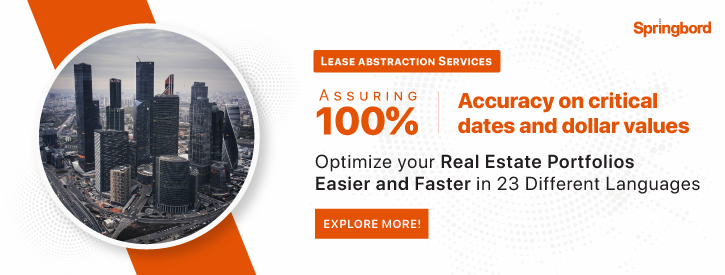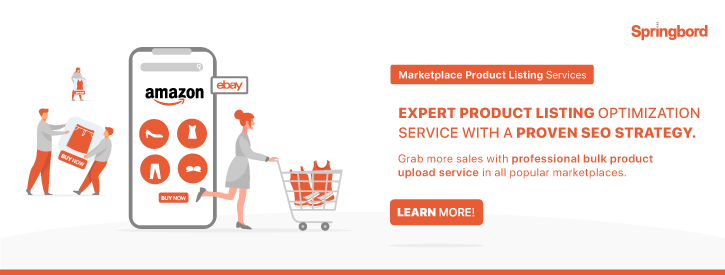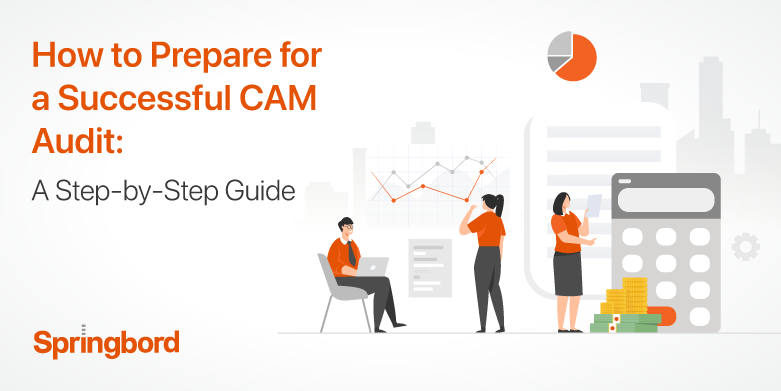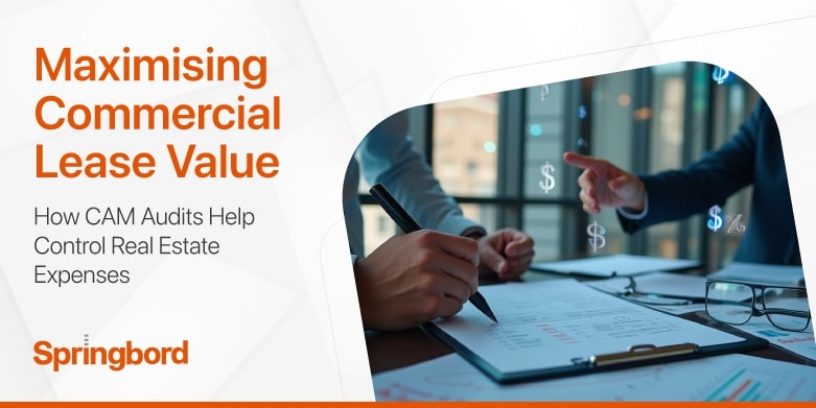 Read time 6 min
Read time 6 minCommon Area Maintenance (CAM) charges often represent a significant portion of total occupancy costs for business owners leasing commercial space.
Yet, these expenses are frequently overlooked or accepted at face value, despite their complexity and potential for error. Overcharges, misallocated expenses, and non-compliant billing practices can quietly erode your bottom line year after year.
This is where CAM audits come into play, not just as a cost-control mechanism, but as a strategic tool for operational efficiency, compliance, and long-term savings. This blog breaks down how seasoned tenants can approach CAM audits to extract value, challenge inconsistencies, and drive smarter real estate decisions.
Understanding CAM Charges in Commercial Leases
As commercial real estate operating costs rise, Common Area Maintenance (CAM) charges continue to be a crucial, yet often misunderstood, component of total occupancy expenses. Business owners and corporate tenants navigating complex lease structures must carefully assess CAM charges to prevent overpayments and ensure full compliance with contractual obligations.
According to the Building Owners and Managers Association (BOMA), CAM expenses can account for 15–35% of a tenant’s total occupancy costs depending on property type and market conditions. Despite their financial significance, CAM charges are frequently subject to opaque categorization, inconsistent allocation, and landlord misinterpretation, leaving tenants exposed to revenue leakage.
What Falls Under CAM
CAM charges are meant to cover expenses related to the operation, repair, and maintenance of shared areas within a commercial property. These typically include:
- Property maintenance and repairs
- Utilities in common areas
- Security, cleaning, and landscaping
- Insurance and property management fees
However, costs like capital improvements or unrelated legal fees are sometimes misclassified as CAM. Without proper review, tenants risk paying for non-reimbursable expenses.
Springbord’s lease abstraction and CAM audit services help tenants validate each charge against lease terms, ensuring accuracy and compliance.
The Problem of Ambiguous Lease Language
One of the most pervasive issues in CAM billing stems from vague or overly broad lease language, which often grants landlords excessive discretion in defining and applying operating expenses. Common challenges include:
- Undefined terms: Words like “reasonable,” “customary,” or “standard” are subjective and exploitable.
- Inconsistent allocation: Expenses not equitably divided among tenants (e.g., vacant space allocations unfairly absorbed by active tenants).
- Bundled fees: Combining management, administrative, and mark-up charges without breakdown or justification.
- Lack of audit transparency: Limited access to supporting documentation and vendor invoices.
According to a 2023 report by JLL, nearly 28% of tenants found discrepancies in their annual CAM reconciliations, yet only a small percentage pursued formal audits.
Springbord’s CAM audit solutions detect these billing issues early, helping clients recover costs and renegotiate with confidence.
The Technical Process of Conducting a CAM Audit

For commercial tenants, CAM (Common Area Maintenance) charges can be difficult to interpret and easy to overlook. Identifying errors or overcharges requires more than just a cursory review. It demands a systematic, data-driven approach rooted in the lease terms. A comprehensive CAM audit involves a multi-step technical process to ensure tenants are paying only their fair share, and not absorbing landlord-side inefficiencies or unrelated costs.
1. Lease Abstraction and Baseline Definition
Every audit begins with a thorough lease abstraction, which involves extracting all critical financial and operational clauses that govern CAM obligations. This process includes:
- Expense inclusion/exclusion clauses
- Administrative or management fee limits
- Pro-rata share calculations and formulas
- Gross-up provisions and expense caps
Without this foundational step, CAM charges cannot be evaluated accurately. Springbord’s lease abstraction services create detailed audit baselines that help tenants navigate even the most complex multi-site lease portfolios with consistency and clarity.
2. Cross-Referencing CAM Statements with Lease Terms
Landlord-issued CAM reconciliations often include bundled or mislabeled charges. Each of these entries must be cross-referenced with the lease terms:
- Are charges billed within the allowed scope?
- Are they accurately calculated based on lease-defined formulas?
- Are year-over-year increases in line with escalation limits?
This review often uncovers discrepancies that tenants miss internally. A 2023 analysis by Tango Analytics found that 40% of CAM reconciliations reviewed across U.S. retail centers had material errors.
3. Allocation Validation and Proportionality Checks
CAM charges must reflect each tenant’s fair share of total building expenses, typically based on square footage or agreed-upon allocation metrics. Auditors validate whether:
- Gross-up calculations are reasonable and documented
- Vacant space isn’t unfairly allocated to occupied units.
- Anchor tenants or owner-occupied units are excluded when appropriate.
A study by National Lease Advisors found that misallocated expenses can inflate CAM charges by up to 18%, particularly in mixed-use properties.
Springbord’s cost allocation reviews ensure each client is charged equitably and in full compliance with lease terms.
4. Vendor Contract Review and Benchmarking
CAM charges are often based on external vendor contracts—security, janitorial, HVAC maintenance, landscaping, etc. However, these are rarely benchmarked or audited by tenants. The audit process includes:
- Reviewing contracts to validate service scopes
- Comparing unit costs with market benchmarks
- Identifying pass-through markups or bundled admin fees
Without vendor-level verification, inflated service costs may be absorbed silently by tenants. Springbord’s audit team conducts contract-level forensic analysis to detect anomalies and flag excessive vendor charges.
5. Timeframe Considerations: Retrospective Review & Statute of Limitations
Tenants can typically audit CAM charges going back two to three years, depending on the lease and jurisdiction. However, missing the allowable review window may mean losing the right to recover overpayments.
Some U.S. states limit lease-related claims to as little as 24 months post-reconciliation, making it critical to act promptly.
Springbord helps clients prioritize high-risk leases and fast-track reviews within the statute limits, preserving their ability to recover excess charges.
Strategic Benefits of CAM Audits for Tenants
Conducting regular CAM audits offers commercial tenants a strategic advantage in managing occupancy costs and ensuring compliance with lease agreements. Beyond immediate financial recoveries, these audits provide long-term benefits that enhance operational efficiency and tenant-landlord relationships.
-
Direct cost recovery and ongoing savings
CAM audits enable tenants to identify and correct billing inaccuracies, leading to immediate cost recoveries. According to industry insights, tenants who engage in professional CAM audits can recover an average of 15–20% of billed CAM charges. This not only rectifies past overpayments but also establishes a precedent for accurate future billings, resulting in sustained cost savings over the lease term.
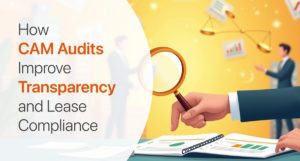
-
Improved transparency in landlord-tenant relations
Regular CAM audits promote transparency by clarifying the allocation and justification of shared expenses. This openness fosters trust between tenants and landlords, reducing the potential for disputes and facilitating smoother lease negotiations. A transparent approach to CAM charges ensures that both parties have a clear understanding of their financial responsibilities, leading to a more collaborative relationship.
-
Strengthened lease negotiation leverage for renewals or expansions
A thorough understanding of CAM charges provides tenants with valuable data that can be leveraged during lease renewals or expansions. Being well-informed about actual operating costs and any discrepancies identified through audits empowers tenants to negotiate more favorable terms, such as caps on CAM charges or more explicit expense definitions. This strategic advantage can lead to more predictable and manageable occupancy costs in future lease agreements.
-
Internal compliance and cost accountability to stakeholders
Conducting CAM audits demonstrates a commitment to internal compliance and fiscal responsibility. By regularly reviewing and validating CAM charges, tenants can ensure adherence to corporate governance standards and financial controls. This proactive approach not only safeguards against financial discrepancies but also reinforces accountability within the organization’s real estate and finance departments.
Incorporating regular CAM audits into a tenant’s financial strategy is not merely a corrective measure but a proactive approach to cost management and operational excellence. By identifying discrepancies, enhancing transparency, strengthening negotiation positions, and ensuring internal compliance, CAM audits serve as a valuable tool in optimizing real estate expenditures and fostering positive landlord-tenant dynamics.
Springbord’s specialized CAM audit services are designed to provide tenants with these strategic benefits, ensuring accurate billing, fostering transparency, and supporting effective lease negotiations.
Conclusion
CAM audits are more than cost-correction tools. They’re strategic safeguards that ensure lease compliance, financial accuracy, and stronger landlord-tenant relationships. In a market where every percentage point matters, regularly auditing CAM charges is essential for long-term savings and operational efficiency.
Don’t let hidden charges slip through the cracks. Springbord helps tenants streamline CAM audits, identify billing discrepancies, and ensure lease compliance through expert lease abstraction and data-driven analysis.
Let our experts simplify your lease data, so you can focus on scaling your business.



